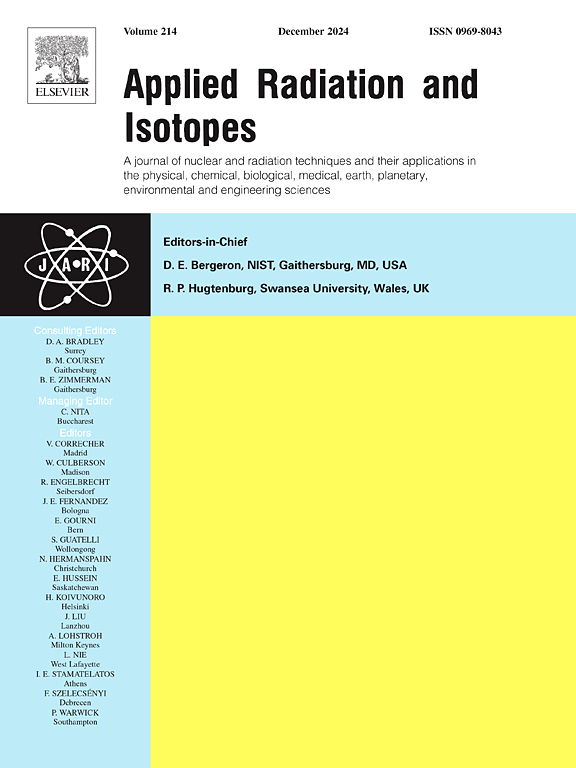Testing a biexponential kinetic model for the heterogeneous isotopic exchange of phosphate ions on several types of soil
IF 1.6
3区 工程技术
Q3 CHEMISTRY, INORGANIC & NUCLEAR
引用次数: 0
Abstract
In this study, a new kinetic equation was applied for the heterogeneous isotopic exchange of phosphate ions on soil. Phosphate sorption on chernozem, marshy meadow and meadow soil was studied by P-32 heterogeneous isotopic exchange in steady-state. The soil samples were incubated with 5 different amounts of KH2PO4 for 1, 3, 13, 10, 12 and 22 weeks. Then they were equilibrated with destilled water, and after the equilibrium was reached, H332PO4 radiotracer was added to the soil solution. At different times samples were taken from the soil solution, and radioactivities were determined by liquid scintillation (LSC) technique. The concentration of phosphate ions was determined by photometry. The relative radioactivity of soil vs time could be fitted well by the biexponential kinetic equation, which assumes two types of weakly bonded phosphate. From the fitting parameters of the biexponential equation and the phosphate concentration determined by photometry the amounts of the two types of weakly bonded phosphate and their steady-state rates were determined. The amounts of weakly bonded phosphate were plotted vs phosphate concentration – data points could be fitted by a Langmuir-like representation or the S-shape sorption isotherms. The rate orders of the desorption proved to be 1 or 2; rate constants were determined. It can be concluded that in some cases cooperative sorption can occure, which can be due to hydrogen bonding between the hydrogenphosphate ions on the surface.
几种土壤中磷离子非均质同位素交换的双指数动力学模型的测试
本文建立了磷离子在土壤中非均相同位素交换的动力学方程。采用稳态P-32非均质同位素交换法研究了黑钙土、沼泽草甸和草甸土壤对磷的吸附。将土壤样品与5种不同量的KH2PO4孵育1、3、13、10、12和22周。然后用蒸馏水平衡,达到平衡后,在土壤溶液中加入H332PO4放射性示踪剂。在不同时间从土壤溶液中取样,用液体闪烁(LSC)技术测定放射性。用光度法测定磷酸盐离子的浓度。土壤相对放射性随时间的变化可以用双指数动力学方程很好地拟合,该方程假设两种弱键磷酸盐。根据双指数方程的拟合参数和光度法测定的磷酸盐浓度,确定了两类弱键磷酸盐的含量及其稳态速率。绘制了弱键磷酸盐的量与磷酸盐浓度的关系,数据点可以用langmuir样表示或s形吸附等温线拟合。解吸的速率阶为1或2;测定了速率常数。可以得出结论,在某些情况下可以发生协同吸附,这可能是由于表面磷酸氢离子之间的氢键。
本文章由计算机程序翻译,如有差异,请以英文原文为准。
求助全文
约1分钟内获得全文
求助全文
来源期刊

Applied Radiation and Isotopes
工程技术-核科学技术
CiteScore
3.00
自引率
12.50%
发文量
406
审稿时长
13.5 months
期刊介绍:
Applied Radiation and Isotopes provides a high quality medium for the publication of substantial, original and scientific and technological papers on the development and peaceful application of nuclear, radiation and radionuclide techniques in chemistry, physics, biochemistry, biology, medicine, security, engineering and in the earth, planetary and environmental sciences, all including dosimetry. Nuclear techniques are defined in the broadest sense and both experimental and theoretical papers are welcome. They include the development and use of α- and β-particles, X-rays and γ-rays, neutrons and other nuclear particles and radiations from all sources, including radionuclides, synchrotron sources, cyclotrons and reactors and from the natural environment.
The journal aims to publish papers with significance to an international audience, containing substantial novelty and scientific impact. The Editors reserve the rights to reject, with or without external review, papers that do not meet these criteria.
Papers dealing with radiation processing, i.e., where radiation is used to bring about a biological, chemical or physical change in a material, should be directed to our sister journal Radiation Physics and Chemistry.
 求助内容:
求助内容: 应助结果提醒方式:
应助结果提醒方式:


